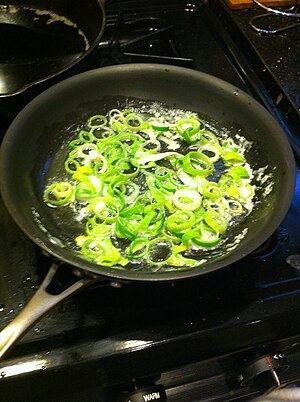Sautéing/ja: Difference between revisions
Created page with "{{DEFAULTSORT:Sauteing}} Category:Cooking techniques Category:Culinary terminology {{二次利用/ja|date=19 April 2025, at 19:13}}" Tags: Mobile edit Mobile web edit |
Created page with "<gallery class="center" caption="ソテー" widths="220px" heights="160px"> File: Sautee onions and peppers.jpg|タマネギとピーマンのソテー File: Baby bella mushrooms being sautéed.jpg|マッシュルームのソテー:ベビーベラ(ポートベロー)マッシュルームのソテー File: US Navy 100610-N-9327W-084 Culinary Specialist 3rd Class Nicholas Roby, from Louisville, Ky., tosses sautéed v..." |
||
| (8 intermediate revisions by the same user not shown) | |||
| Line 3: | Line 3: | ||
'''ソテー'''('''Sautéing''' or '''sauteing''')({{IPAc-en|UK|ˈ|s|əʊ|t|eɪ|ɪ|ŋ}}、{{IPAc-en|US|s|oʊ|ˈ|t|eɪ|ɪ|ŋ|,_|s|ɔː|-}}; フランス語の「sauté」({{IPA|fr|sote|lang}})に由来し、「跳ねる」「飛び跳ねる」といった意味で、調理中に食材を toss することに言及している。)とは、少量の[[Cooking oil/ja|食用油]]や[[fat/ja|油脂]]を浅い鍋に入れ、比較的高温で加熱する調理法である。様々なソテーの方法が存在する。 | '''ソテー'''('''Sautéing''' or '''sauteing''')({{IPAc-en|UK|ˈ|s|əʊ|t|eɪ|ɪ|ŋ}}、{{IPAc-en|US|s|oʊ|ˈ|t|eɪ|ɪ|ŋ|,_|s|ɔː|-}}; フランス語の「sauté」({{IPA|fr|sote|lang}})に由来し、「跳ねる」「飛び跳ねる」といった意味で、調理中に食材を toss することに言及している。)とは、少量の[[Cooking oil/ja|食用油]]や[[fat/ja|油脂]]を浅い鍋に入れ、比較的高温で加熱する調理法である。様々なソテーの方法が存在する。 | ||
==概要{{Anchor|Description}}== | |||
==Description== | ソテーする食材は、通常、調理時間を短縮するために[[:en:surface area|表面積]]が大きくなるように小さく切るか、薄くスライスされる。ソテーにおける主要な熱伝達様式は、フライパンと調理される食材間の伝導である。ソテーされた食材は、その食感、水分、風味を保ちながら[[Browning (food process)/ja|褐色]]になる。肉、鶏肉、魚をソテーする場合、しばしば、フライパンに残った残留物を[[deglazing (cooking)/ja|デグラッセ]]して[[sauce/ja|ソース]]を作ることでソテーを仕上げる。 | ||
ソテーは[[pan frying/ja|パンフライ]]と比較されることがある。パンフライでは、より大きな食材(例:チョップやステーキ)を油や脂で素早く調理し、両面をひっくり返す。一部の料理人は使用する油の深さに基づいて両者を区別するが、他の料理人はこれらの用語を互換的に使用する。 | |||
ソテーは、食品の表面のみを褐色にする[[searing/ja|焼付け]]とは異なる。 | |||
発煙点が低いため、特定の油はソテーに使用すべきではない。[[Clarified butter/ja|澄ましバター]]、[[rapeseed oil/ja|菜種油]]、[[sunflower oil/ja|ひまわり油]]はソテーによく使用される。どのような油脂であっても、ソテーが行われる中〜強火での調理を可能にする十分な高い発煙点を持っていなければならない。例えば、[[Butter/ja|通常のバター]]はより多くの風味を与えるが、乳固形分が存在するため、他の油脂よりも低い温度でより早く焦げる。澄ましバターはこの用途により適している。 | |||
==調理法{{Anchor|Methods}}== | |||
==Methods== | ソテーでは、すべての食材を一度に加熱し、素早く調理する。これを容易にするため、調理器具を使用するか、フライパン自体を繰り返し素早く揺り動かすことによって、食材をフライパンの中で素早く移動させる。ソテーパンは、蒸気が逃げることができるように、すべての食材を一層に広げられる十分な大きさでなければならない。これにより、食材が[[stewing/ja|煮詰まる]]のを防ぎ、[[fond/ja|フォン]]の生成を促進する。ソテーパンとして特売されているほとんどのフライパンは、加熱に利用できる表面積を最大化するために、広い平らな底と低い側面を持っている。低い側面は、素早い蒸発と蒸気の排出を可能にする。[[:en:skillet|スキレット]]が通常、広がった側面や丸みを帯びた側面を持っているのに対し、ソテーパンは通常、まっすぐな垂直な側面を持っている。これにより、フライパンを揺り動かしたりかき混ぜたりしても、食材が飛び出すのを防ぐ。 | ||
ソテーに必要な油脂は、フライパンの底を軽く覆う程度で十分である。多すぎる油脂は、食材がただ滑るだけでなく揚げる原因となり、[[fond/ja|フォン]]の生成を妨げる可能性がある。食材は熱い油脂の入ったフライパンに広げられ、[[Browning (food process)/ja|褐色]]になるまで放置され、均一に調理するために頻繁に裏返したり揺り動かしたりする。ソテーの技術には、ソテーパンの柄をしっかりと握り、鋭い肘の動きを使ってフライパンを素早く手前に引く動作を、食材が十分に跳ね上がるように必要に応じて繰り返すことが含まれる。ただし、フライパンをあまりにも頻繁に揺さぶって食材を トスしたりかき混ぜたりすると、フライパンが冷えてソテーに時間がかかることがある。 | |||
<gallery class="center" caption="ソテー" widths="220px" heights="160px"> | |||
<gallery class="center" caption=" | File: Sautee onions and peppers.jpg|タマネギとピーマンのソテー | ||
File: Sautee onions and peppers.jpg| | File: Baby bella mushrooms being sautéed.jpg|[[Sautéed mushrooms/ja|マッシュルームのソテー]]:ベビーベラ([[Agaricus bisporus/ja|ポートベロー]])マッシュルームのソテー | ||
File: Baby bella mushrooms being sautéed.jpg|[[Sautéed mushrooms]] | File: US Navy 100610-N-9327W-084 Culinary Specialist 3rd Class Nicholas Roby, from Louisville, Ky., tosses sautéed vegetables in the commanding officer's galley aboard the amphibious assault ship USS Nassau (LHA 4).jpg|ソテーパンで野菜を toss する様子。強襲揚陸艦USS Nassau (LHA 4) の艦長用厨房にて、ケンタッキー州ルイビル出身の調理専門家3等兵曹 Nicholas Roby が調理中。 | ||
File: US Navy 100610-N-9327W-084 Culinary Specialist 3rd Class Nicholas Roby, from Louisville, Ky., tosses sautéed vegetables in the commanding officer's galley aboard the amphibious assault ship USS Nassau (LHA 4).jpg| | File:Flambé in a sauté pan.jpg|ソテーパンでの[[Flambé/ja|フランベ]] | ||
File:Flambé in a sauté pan.jpg|[[Flambé]] | |||
</gallery> | </gallery> | ||
==関連項目== | |||
{{portal|Cooking|Food}} | {{portal|Cooking|Food}} | ||
{{div col|colwidth=30em}} | {{div col|colwidth=30em}} | ||
* [[Pan frying]] | * [[Pan frying/ja]] | ||
* [[Saucier]] | * [[Saucier/ja]] | ||
* [[Stir frying]] | * [[Stir frying/ja]] | ||
* [[Sweating (cooking)]] | * [[Sweating (cooking)/ja]] | ||
* [[Tempering (spices)]] | * [[Tempering (spices)/ja]] | ||
{{div col end}} | {{div col end}} | ||
==外部リンク== | |||
* {{commons-inline|Sautéing}} | |||
* {{commons-inline}} | |||
* {{Cookbook-inline|Sautéing}} | * {{Cookbook-inline|Sautéing}} | ||
{{Cooking techniques/ja}} | {{Cooking techniques/ja}} | ||
Latest revision as of 21:14, 31 May 2025

ソテー(Sautéing or sauteing)(UK: /ˈsoʊteɪɪŋ/、US: /soʊˈteɪɪŋ, sɔː-/; フランス語の「sauté」(fr)に由来し、「跳ねる」「飛び跳ねる」といった意味で、調理中に食材を toss することに言及している。)とは、少量の食用油や油脂を浅い鍋に入れ、比較的高温で加熱する調理法である。様々なソテーの方法が存在する。
概要
ソテーする食材は、通常、調理時間を短縮するために表面積が大きくなるように小さく切るか、薄くスライスされる。ソテーにおける主要な熱伝達様式は、フライパンと調理される食材間の伝導である。ソテーされた食材は、その食感、水分、風味を保ちながら褐色になる。肉、鶏肉、魚をソテーする場合、しばしば、フライパンに残った残留物をデグラッセしてソースを作ることでソテーを仕上げる。
ソテーはパンフライと比較されることがある。パンフライでは、より大きな食材(例:チョップやステーキ)を油や脂で素早く調理し、両面をひっくり返す。一部の料理人は使用する油の深さに基づいて両者を区別するが、他の料理人はこれらの用語を互換的に使用する。
ソテーは、食品の表面のみを褐色にする焼付けとは異なる。
発煙点が低いため、特定の油はソテーに使用すべきではない。澄ましバター、菜種油、ひまわり油はソテーによく使用される。どのような油脂であっても、ソテーが行われる中〜強火での調理を可能にする十分な高い発煙点を持っていなければならない。例えば、通常のバターはより多くの風味を与えるが、乳固形分が存在するため、他の油脂よりも低い温度でより早く焦げる。澄ましバターはこの用途により適している。
調理法
ソテーでは、すべての食材を一度に加熱し、素早く調理する。これを容易にするため、調理器具を使用するか、フライパン自体を繰り返し素早く揺り動かすことによって、食材をフライパンの中で素早く移動させる。ソテーパンは、蒸気が逃げることができるように、すべての食材を一層に広げられる十分な大きさでなければならない。これにより、食材が煮詰まるのを防ぎ、フォンの生成を促進する。ソテーパンとして特売されているほとんどのフライパンは、加熱に利用できる表面積を最大化するために、広い平らな底と低い側面を持っている。低い側面は、素早い蒸発と蒸気の排出を可能にする。スキレットが通常、広がった側面や丸みを帯びた側面を持っているのに対し、ソテーパンは通常、まっすぐな垂直な側面を持っている。これにより、フライパンを揺り動かしたりかき混ぜたりしても、食材が飛び出すのを防ぐ。
ソテーに必要な油脂は、フライパンの底を軽く覆う程度で十分である。多すぎる油脂は、食材がただ滑るだけでなく揚げる原因となり、フォンの生成を妨げる可能性がある。食材は熱い油脂の入ったフライパンに広げられ、褐色になるまで放置され、均一に調理するために頻繁に裏返したり揺り動かしたりする。ソテーの技術には、ソテーパンの柄をしっかりと握り、鋭い肘の動きを使ってフライパンを素早く手前に引く動作を、食材が十分に跳ね上がるように必要に応じて繰り返すことが含まれる。ただし、フライパンをあまりにも頻繁に揺さぶって食材を トスしたりかき混ぜたりすると、フライパンが冷えてソテーに時間がかかることがある。
- ソテー
-
タマネギとピーマンのソテー
-
マッシュルームのソテー:ベビーベラ(ポートベロー)マッシュルームのソテー
-
ソテーパンで野菜を toss する様子。強襲揚陸艦USS Nassau (LHA 4) の艦長用厨房にて、ケンタッキー州ルイビル出身の調理専門家3等兵曹 Nicholas Roby が調理中。
-
ソテーパンでのフランベ
関連項目
外部リンク
 Media related to Sautéing at Wikimedia Commons
Media related to Sautéing at Wikimedia Commons [[wikibooks:Cookbook:Sautéing |]] at the Wikibooks Cookbook subproject
[[wikibooks:Cookbook:Sautéing |]] at the Wikibooks Cookbook subproject
| この記事は、クリエイティブ・コモンズ・表示・継承ライセンス3.0のもとで公表されたウィキペディアの項目Sautéing(19 April 2025, at 19:13編集記事参照)を翻訳して二次利用しています。 |



